
Nambu Market: The Heartbeat of Jeonju's Culinary and Cultural Scene
Discover the bustling Nambu Market in Jeonju, a vibrant hub of culinary delights, rich history, and local culture, perfect for foodies and culture enthusiasts alike.
Nambu Market in Jeonju, South Korea, is a vibrant hub of activity and a sensory delight for tourists eager to immerse themselves in local culture. Established over a century ago, this market is a testament to Jeonju's rich history and culinary heritage. As you wander through its bustling alleys, you'll be greeted by a kaleidoscope of colors and aromas emanating from countless stalls selling everything from fresh produce to handmade crafts. Food lovers will find Nambu Market particularly irresistible. The market is renowned for its diverse array of street food, including the famous Jeonju bibimbap, a delicious rice dish topped with a variety of vegetables, meat, and a spicy sauce. Don't miss the opportunity to try other local delicacies such as moju, a traditional Korean liquor made from rice and medicinal herbs, and the array of freshly made kimchi that Jeonju is known for. Beyond its culinary offerings, Nambu Market also provides a glimpse into the daily lives of Jeonju's residents. The market is a lively social space where locals gather to shop, eat, and catch up on the latest news. The friendly vendors are often eager to share stories and offer samples, making your visit both enjoyable and informative. Whether you're looking to purchase unique souvenirs or simply soak in the vibrant atmosphere, Nambu Market is a must-visit destination in Jeonju.
Local tips in Nambu Market
- Visit in the morning to experience the market at its liveliest and enjoy the freshest produce.
- Try the Jeonju bibimbap from different stalls to savor various takes on this iconic dish.
- Carry some cash, as many vendors may not accept credit cards.
- Engage with the vendors; they often have interesting stories and may offer you samples.
- Wear comfortable shoes, as you'll be doing a lot of walking through the market's extensive alleys.
Nambu Market: The Heartbeat of Jeonju's Culinary and Cultural Scene
Nambu Market in Jeonju, South Korea, is a vibrant hub of activity and a sensory delight for tourists eager to immerse themselves in local culture. Established over a century ago, this market is a testament to Jeonju's rich history and culinary heritage. As you wander through its bustling alleys, you'll be greeted by a kaleidoscope of colors and aromas emanating from countless stalls selling everything from fresh produce to handmade crafts. Food lovers will find Nambu Market particularly irresistible. The market is renowned for its diverse array of street food, including the famous Jeonju bibimbap, a delicious rice dish topped with a variety of vegetables, meat, and a spicy sauce. Don't miss the opportunity to try other local delicacies such as moju, a traditional Korean liquor made from rice and medicinal herbs, and the array of freshly made kimchi that Jeonju is known for. Beyond its culinary offerings, Nambu Market also provides a glimpse into the daily lives of Jeonju's residents. The market is a lively social space where locals gather to shop, eat, and catch up on the latest news. The friendly vendors are often eager to share stories and offer samples, making your visit both enjoyable and informative. Whether you're looking to purchase unique souvenirs or simply soak in the vibrant atmosphere, Nambu Market is a must-visit destination in Jeonju.
Iconic landmarks you can’t miss
Jeonju Hanok Village
Experience the rich heritage and vibrant culture of Jeonju Hanok Village, a traditional Korean village filled with exquisite architecture and culinary delights.
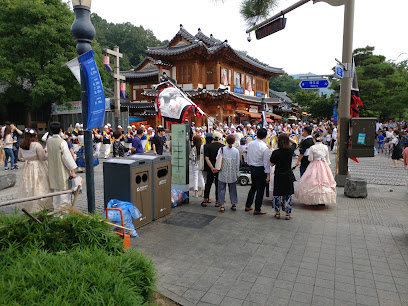
Nambu Market
Discover the vibrant Nambu Market in Jeonju, South Korea, where culinary delights and rich culture come together in a lively atmosphere.
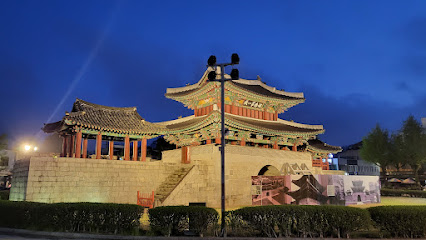
Gyeonggijeon Shrine
Explore Gyeonggijeon Shrine, a historical landmark in Jeonju, and experience the cultural richness of Korea's royal heritage amid serene gardens and stunning architecture.

Jaman Mural Village
Discover the artistic charm of Jaman Mural Village, a vibrant neighborhood in Jeonju-si filled with breathtaking murals and rich cultural experiences.

Pungnammun Gate
Discover the historical charm of Pungnammun Gate in Jeonju, a magnificent symbol of Korea's rich heritage and architectural beauty.

Cheongyeollu
Explore Cheongyeollu, a serene tourist attraction in Jeonju, South Korea, where nature and culture meet in perfect harmony.

Youth Market
Discover the Youth Market in Jeonju: A vibrant fusion of street food, local crafts, and cultural experiences awaits you in this lively marketplace.
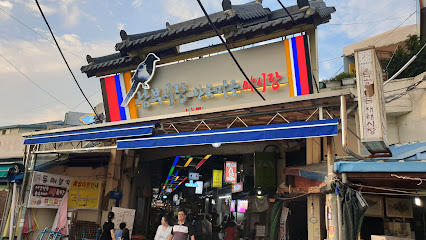
Jeonju Nanjang
Experience the thrill and culture at Jeonju Nanjang, Jeonju's premier theme park blending excitement with traditional Korean entertainment.

Omokdae
Explore the historical significance and stunning views of Omokdae, a cultural gem in Jeonju, South Korea.
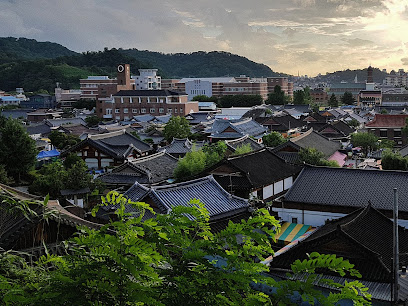
Hanbyeokdang Pavilion
Explore the serene beauty and rich history of Hanbyeokdang Pavilion, a gem in Jeonju, South Korea, perfect for cultural immersion and relaxation.

Unmissable attractions to see
Nambu Market
Discover the vibrant Nambu Market in Jeonju, a culinary paradise and cultural attraction showcasing local flavors and traditional crafts.

Jeondong Cathedral
Discover the architectural beauty and serene atmosphere of Jeondong Cathedral, a must-see Catholic church in Jeonju, South Korea.

Jeonju Hyanggyo
Explore the serene beauty and historical significance of Jeonju Hyanggyo, a cultural gem nestled in the heart of Jeonju, South Korea.

Jaman Mural Village
Explore the vibrant murals and rich culture of Jaman Mural Village, a must-visit artistic haven in Jeonju-si, South Korea.

Youth Market
Experience the vibrant atmosphere of the Youth Market in Jeonju, where local crafts meet delicious street food in a cultural hub.

Essential places to dine
Veteran Kalguksu
Discover authentic Korean flavors at Veteran Kalguksu in Jeonju - home of the finest handmade noodles and delicious broths.

조점례남문피순대
Discover the essence of Korean breakfast at 조점례남문피순대 in Jeonju – where tradition meets flavor.

삼백집 본점
Experience authentic Korean cuisine at 삼백집 본점 in Jeonju – where tradition meets taste in every delicious bite.

Hangugjib
Discover the authentic taste of Korea at Hangugjib in Jeonju - where tradition meets flavor in every dish.

Mereumil Jinmijip
Discover the rich flavors of Korea at Mereumil Jinmijip – a must-visit noodle shop in Jeonju offering authentic dishes in a welcoming atmosphere.

45-year-old traditional bibimbap Jongno Hall
Experience authentic Korean bibimbap at Traditional Bibimbap Jongno Hall in Jeonju - where tradition meets flavor.

Haeyuldam
Discover Haeyuldam in Jeonju-si - where exceptional barbecue meets vibrant dining culture.

옛날피순대
Discover authentic Korean Soondae at Yeonnal Pisundae in Jeonju—an affordable culinary gem steeped in tradition and flavor.

Jeonju hanok village restaurant jeonju is jeonju
Experience authentic Korean cuisine in a historic setting at Jeonju Hanok Village – a culinary gem in South Korea.

Nadeulbul
Experience authentic Korean flavors at Nadeulbul in Jeonju – where tradition meets taste in every delightful dish.

Yangsigdang
Experience authentic Italian cuisine at Yangsigdang in Jeonju - where fresh ingredients meet traditional recipes for an unforgettable dining experience.

Hawaiian recipe
Experience the vibrant flavors of Hawaii right in Jeonju with authentic dishes made from fresh ingredients in a warm and inviting atmosphere.

우정식당
Discover authentic Korean flavors at 우정식당 in Jeonju – a culinary haven showcasing traditional dishes made with fresh local ingredients.

백수의 찬
Experience authentic Korean cuisine at 백수의 찬 in Jeonju – a culinary haven where tradition meets flavor.

현대옥 남부시장점
Experience authentic Korean cuisine at 현대옥 남부시장점 in Jeonju—a must-visit destination for food lovers seeking traditional flavors.

Markets, malls and hidden boutiques
Jeonju Hanok Village
Experience the enchanting beauty and rich culture of Jeonju Hanok Village, a traditional Korean gem brimming with history and delicious cuisine.
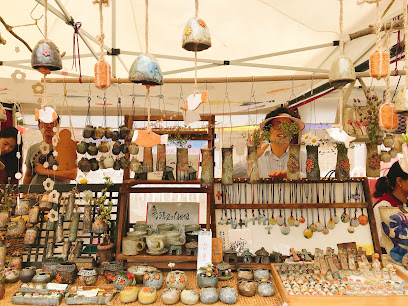
Nambu Market
Experience the essence of Jeonju at Nambu Market, where traditional flavors and vibrant culture come together in a unique shopping adventure.

LOTTE Department Store Jeonju
Explore LOTTE Department Store Jeonju: Your gateway to shopping, dining, and cultural experiences in the heart of Jeonju, Korea.

Pungnammun Gate
Discover the rich history of Jeonju through the magnificent Pungnammun Gate, a stunning symbol of Korea's architectural heritage.

Youth Market
Experience the lively Youth Market in Jeonju, where shopping, local cuisine, and culture come together in a vibrant atmosphere.

Moraenae Market
Experience the vibrant culture and delicious flavors at Moraenae Market, Jeonju's beloved traditional market, perfect for food lovers and culture seekers.

Gaekridan-gil Road
Explore Gaekridan-gil Road, a vibrant blend of tradition and modernity in Jeonju, where delicious street food meets rich cultural heritage.

Jeonju hanok village hanbok rental HANBOKNAM
Explore the cultural heart of Korea at Jeonju Hanok Village with HANBOKNAM, where traditional hanboks transform your visit into a timeless experience.

Jeonju Crafts Exhibition Hall
Experience the rich artistry of Jeonju at the Crafts Exhibition Hall, a vibrant showcase of local handicrafts and cultural heritage.

전라난백화점
Explore 전라난백화점 in Jeonju for unique gifts and authentic Korean souvenirs that capture the essence of local craftsmanship.

Essential bars & hidden hideouts
Nomadic Beer Garden 노매딕 비어가든
Explore the vibrant Nomadic Beer Garden in Jeonju, where craft beers meet lively ambiance for an unforgettable experience.
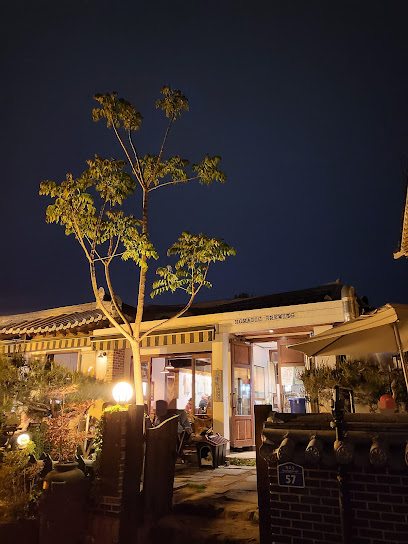
Nomadic Brewing Company
Explore the flavors of craft beer at Nomadic Brewing Company, Jeonju's premier destination for seasonal brews and a vibrant atmosphere.

Bar Cold Dawn
Discover the artistic cocktails and warm ambiance of Bar Cold Dawn, the perfect spot to unwind in Jeonju's vibrant nightlife.

Jinju Doga
Experience the vibrant nightlife at Jinju Doga, a premier bar in Jeonju offering a mix of local flavors and lively entertainment.

Deepin
Experience the vibrant nightlife at Deepin, a top pub in Jeonju offering a variety of drinks and a lively atmosphere perfect for socializing.

Pub Ink
Discover the vibrant nightlife at Pub Ink, a top bar in Jeonju-si offering exquisite drinks and a lively atmosphere for an unforgettable experience.

Afternoon & Wine
Experience the perfect blend of comfort and fine wines at Afternoon & Wine, Jeonju's premier wine bar.

Mystery Mansion
Discover the enchanting Mystery Mansion in Jeonju, where delightful drinks meet a whimsical atmosphere, perfect for an unforgettable night out.

Pul
Discover Pul Bar in Jeonju: A lively spot blending traditional Korean vibes with modern drink culture for an unforgettable night out.

작은루페
Discover the charm of Jeonju's nightlife at 작은루페, where local flavors and a cozy atmosphere create an unforgettable experience.

Local Phrases
-
- Hello안녕하세요
[ahn-nyeong-ha-se-yo] - Goodbye안녕히 가세요
[ahn-nyeong-hee ga-se-yo] - Yes네
[ne] - No아니요
[a-ni-yo] - Please/You're welcome부탁합니다/천만에요
[boo-tak-ham-ni-da/cheon-man-e-yo] - Thank you감사합니다
[gam-sa-ham-ni-da] - Excuse me/Sorry죄송합니다
[joe-song-ham-ni-da] - How are you?어떻게 지내세요?
[eo-tteo-ke ji-nae-se-yo?] - Fine. And you?잘 지내요. 그리고 당신은요?
[jal ji-nae-yo. geu-ri-go dang-shin-eun-yo?] - Do you speak English?영어 할 수 있어요?
[yeong-eo hal-su i-sseo-yo?] - I don't understand이해하지 못해요
[i-hae-ha-ji mo-hae-yo]
- Hello안녕하세요
-
- I'd like to see the menu, please메뉴판을 보고 싶어요
[me-nyu-pan-eul bo-go ship-eo-yo] - I don't eat meat고기를 먹지 않아요
[go-gi-reul meok-ji a-na-yo] - Cheers!건배!
[geon-bae!] - I would like to pay, please결제하고 싶어요
[gyeol-je-ha-go ship-eo-yo]
- I'd like to see the menu, please메뉴판을 보고 싶어요
-
- Help!도와주세요!
[do-wa-ju-se-yo!] - Go away!가세요!
[ga-se-yo!] - Call the Police!경찰을 불러주세요!
[gyeong-chal-eul bul-leo-ju-se-yo!] - Call a doctor!의사를 불러주세요!
[ui-sa-reul bul-leo-ju-se-yo!] - I'm lost길을 잃었어요
[gil-eul ilh-eos-seo-yo] - I'm ill아파요
[a-pa-yo]
- Help!도와주세요!
-
- I'd like to buy...구입하고 싶어요...
[gu-ip-ha-go ship-eo-yo...] - I'm just looking구경만 하고 있어요
[gu-gyeong-man ha-go i-sseo-yo] - How much is it?얼마에요?
[eol-ma-e-yo?] - That's too expensive너무 비싸요
[neo-mu bi-ssa-yo] - Can you lower the price?가격을 깎아 주실 수 있어요?
[ga-geuk-eul kka-ga ju-shil su i-sseo-yo?]
- I'd like to buy...구입하고 싶어요...
-
- What time is it?지금 몇 시에요?
[ji-geum myeot si-e-yo?] - It's one o'clock한 시에요
[han si-e-yo] - Half past (10)십 이십 분
[ship i-ship bun] - Morning아침
[a-chim] - Afternoon오후
[o-hu] - Evening저녁
[jeo-nyeok] - Yesterday어제
[eo-je] - Today오늘
[o-neul] - Tomorrow내일
[nae-il] - 1일
[il] - 2이
[i] - 3삼
[sam] - 4사
[sa] - 5오
[o] - 6육
[yuk] - 7칠
[chil] - 8팔
[pal] - 9구
[gu] - 10십
[ship]
- What time is it?지금 몇 시에요?
-
- Where's a/the...?...이 어디에 있어요?
[...i eo-di-e iss-eo-yo?] - What's the address?주소가 뭐에요?
[ju-so-ga mwo-e-yo?] - Can you show me (on the map)?지도로 보여주세요?
[ji-do-ro bo-yeo-ju-se-yo?] - When's the next (bus)?다음 버스는 언제에요?
[da-eum beo-seu-neun eon-je-e-yo?] - A ticket (to ....)표를 주세요 (....으로)
[pyo-reul ju-se-yo (...eu-ro)]
- Where's a/the...?...이 어디에 있어요?
History of Nambu Market
-
Nambu Market, established in the early 20th century, has long been a vital part of Jeonju's economy and culture. Originally a traditional market, it became a bustling center for commerce, showcasing local produce, handicrafts, and traditional Korean goods. The market is emblematic of Jeonju's rich history, reflecting the city's role as a significant trading hub in the region.
-
During the Japanese occupation of Korea (1910-1945), Nambu Market experienced significant changes. The Japanese authorities modernized the market's infrastructure to facilitate trade and control. This period saw the introduction of new goods and services, which altered the traditional market dynamics. Despite these changes, Nambu Market retained its cultural essence as a meeting point for locals and a showcase of Korean resilience.
-
In the 1980s, Nambu Market underwent a revival as part of a broader movement to preserve traditional markets in South Korea. With the growing interest in local foods and crafts, the market became a hub for Jeonju's famed culinary offerings, including bibimbap and other regional specialties. This resurgence helped to reinforce the cultural identity of Jeonju and established Nambu Market as a must-visit destination for both locals and tourists.
-
In recent years, Nambu Market has hosted various cultural festivals that celebrate Jeonju's heritage. These events often feature traditional music, dance, and food, creating a vibrant atmosphere that attracts visitors from all over. The market plays a crucial role in fostering community engagement and preserving local traditions, making it a living testament to Jeonju's cultural landscape.
-
Today, Nambu Market continues to thrive amidst modern developments. Efforts have been made to blend contemporary conveniences with traditional market charm. Local artisans and vendors still showcase their goods, and the market serves as a critical platform for promoting Jeonju's unique cultural heritage and culinary delights. Preservation initiatives aim to maintain the market's historical significance while adapting to the evolving needs of the community.
Nambu Market Essentials
-
Nambu Market is centrally located in Jeonju, making it easily accessible from various neighborhoods. If you are coming from Jeonju Station, you can take a local bus (routes 1, 3, or 5) that directly connects to Nambu Market. Alternatively, taxis are readily available and provide a quick, convenient option for reaching the market. If you are staying in Hanok Village, Nambu Market is about a 15-minute walk, making it a pleasant stroll through the city.
-
Nambu Market is pedestrian-friendly, and many visitors choose to explore on foot. The market itself is a maze of stalls and shops that are best navigated on foot. Public buses are also available for reaching nearby attractions. For a more local experience, consider renting a bicycle from a nearby rental shop, as there are bike lanes leading to and from the market area.
-
Nambu Market is generally safe for tourists, but standard safety precautions should be observed. Avoid displaying valuables and be cautious in crowded areas where pickpocketing may occur. It is advisable to steer clear of poorly lit alleys, especially at night. While crime targeting tourists is rare, maintaining awareness of your surroundings will enhance your safety.
-
In case of an emergency, dial 112 for police assistance or 119 for fire and medical emergencies. There are hospitals and pharmacies nearby Nambu Market, with signs in English. It is recommended to carry travel insurance that covers medical emergencies. For minor health issues, local pharmacies can provide over-the-counter medications.
-
Fashion: Do dress comfortably and appropriately for the weather; avoid overly revealing clothing. Religion: Do be respectful when visiting nearby temples and shrines, and observe any specific customs. Public Transport: Do give your seat to the elderly or pregnant women. Don't use your phone loudly on buses or trains. Greetings: Do greet locals with a smile and a slight bow. Eating & Drinking: Do try local street food and share meals with friends. Don't eat while walking in the market; it is considered impolite.
-
To experience Nambu Market like a local, visit early in the morning to enjoy the bustling atmosphere and fresh produce. Engage with local vendors, many of whom are happy to share stories about their products. Don't miss trying Jeonju's famous bibimbap from one of the market's food stalls. Be sure to explore the side alleys for hidden gems and unique souvenirs.
Nearby Cities to Nambu Market
-
Things To Do in Daejeon
-
Things To Do in Gwangju
-
Things To Do in Suncheon
-
Things To Do in Daegu
-
Things To Do in Mokpo
-
Things To Do in Suwon
-
Things To Do in Andong
-
Things To Do in Busan
-
Things To Do in Incheon
-
Things To Do in Gyeongju
-
Things To Do in Ulsan
-
Things To Do in Seoul
-
Things To Do in Pohang
-
Things To Do in Chuncheon
-
Things To Do in Jeju City







